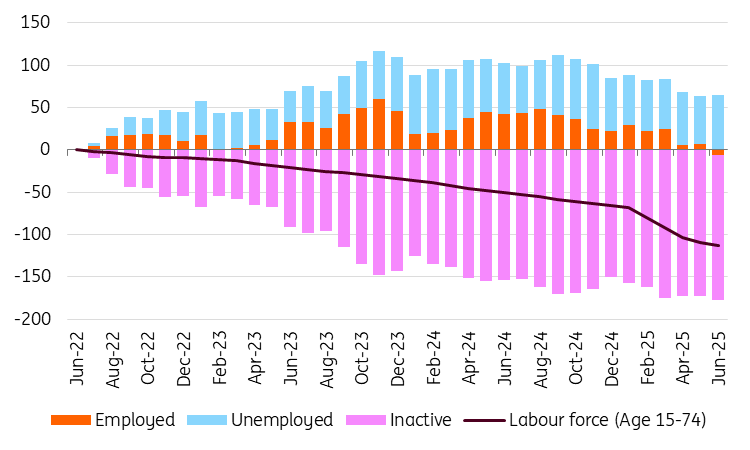Hungarian Labor Supply And Demand Softens

Image Source: Pexels
Shifts in demographics and labor force participation were key drivers behind the decline in employment in the second quarter of 2025. With labour demand softening alongside supply, a near-term recovery seems unlikely.
The latest labor market statistics from the Hungarian Central Statistical Office are broadly in line with market expectations for June. The model estimate shows an unemployment rate of 4.3% in June 2025, unchanged from the previous month. However, the official three-month moving average survey for the second quarter shows that the unemployment rate rose by 0.2ppt to 4.5%. While this increase is disappointing, as the ratio remains below the temporary peak seen in 2024, it is not cause for alarm. In terms of the number of unemployed individuals, both statistics estimate that this group comprises around 210,000 to 220,000 people.
Examining the monthly data in more detail, we can see that the number of inactive people fell by 14,000 compared to the previous month – a stronger decline than that seen in the working-age population. At the same time, however, employment increased by 10,000. This modest improvement is presumably due to seasonal work in the early summer, primarily in the agriculture sector. Additionally, the number of unemployed people increased slightly. Taken together, these fluctuations in the labour market are indicative of meaningful changes, with seasonal work in agriculture (and probably construction) masking the impact of quiet layoffs in other sectors.
Historical trends in the Hungarian labor market (%)

Source: HCSO, ING
Second quarter data shows that the number of people in employment has continued to decrease, reaching its lowest level since the beginning of 2022. However, this is due to demographic trends and slowing labour market activity; there is no evidence of a drastic change in the employment rate itself. At 65.1%, the second quarter figure is in line with the average of the last two years.
The stagnation of the employment rate clearly indicates that supply constraints are becoming increasingly effective in the Hungarian labor market. The combination of depopulation and voluntary labour market exit, as well as firms' labour hoarding, is still keeping the market relatively tight. So why can’t we see an even tighter labor market? Because the demand side is also weakening hand in hand with the supply side due to the economic stagnation since mid-2022.
Cumulative changes in the labor market since mid-2022 (3m-ma)

Source: HCSO, ING
Looking ahead, we do not expect these trends to change significantly soon. A demographic turnaround is not anticipated, and we see the current trend of inactivity persisting alongside the shrinking of job opportunities. In our view, workers' bargaining power is clearly weakening, particularly because of the gloomy economic outlook. It will be interesting to see what happens to the multi-year minimum wage agreement, which calls for substantial increases of 13% and 14% over the next two years, respectively.
This could create significant tensions in the labor market. If the economic activity does not improve, companies may seek to maintain their wage bills by raising wages and reducing staff numbers. Despite the latest data, we are not changing our labour market forecast of an unemployment rate of around 4.5% for the rest of the year. However, we do see potential for the labor market to weaken further.
More By This Author:
Italian Confidence Edges Higher As Modest Growth Path Holds FirmFX Daily: Trade Deals Fuel Sense Of Optimism
Tokyo Inflation Cooling, But Still Elevated Enough To Keep BoJ Normalisation On Track
Disclaimer: This publication has been prepared by the Economic and Financial Analysis Division of ING Bank N.V. (“ING”) solely for information purposes without regard to any ...
more


